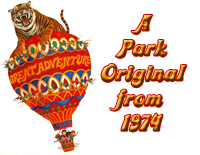
Animal attractions and shows often went hand in hand with fairs and
amusement parks, and with the rise of theme parks, animal shows became a
staple attraction in parks around the world. The success of marine life
parks like Marineland and SeaWorld led to many theme parks introducing
marine mammal shows often featuring Atlantic bottle nose dolphins or
California sea lions as the star performers.
|
| |
|
|
 |
 |
 |
| |
|
 |
 |
| |
|

 |
One of the largest
and most complex structures built for the opening of Great Adventure in
the spring of 1974 was the Aqua Spectacle Stadium. The massive structure
was one of the largest of its kind at the time, featuring seating for
thousands of guests and a pool that would be deep enough for both the
marine mammals it was to host as well as for high divers.
The 16
foot deep pool fit the bill for both uses and the stadium seating
afforded a great view to all in attendance. Since the pool was to be
filled with salt water for the dolphins, a series of complex tanks and
pumps was constructed beneath the seats to create that salt water as
well as continually filter and circulate it.
The concrete pool
was crowned with a steel structure to support the rows of seats, and the
structure was completed with concrete panel walls covered with stucco to
give the building a finished look. |
 |
| |
 |
| |
Click for the expanded

Spotlight with dozens of photos! |
|
 |
 |
| |
|
|
 |
 |
 |
|
|
|
|
 |
The Aqua Spectacle
hosted diving and dolphin shows from the day Great Adventure opened, and
without a doubt they were some of the most popular attractions in the
park. Huge crowds would line up to get into the stadium with up to six
shows of the dolphins and six shows of the divers alternating throughout
the day.
The neighboring Woodland Gardens area was designed to
act as a queue area for the stadium, allowing the guests to wait for the
stadium to line up as the previous show was concluding.
The original shows at the Aqua Spectacle were really unique. While most
parks that had dolphin shows at the time had two or three performing
animals, Great Adventure featured ten performing at one time.
The diving shows featured an array of dives from platforms of varying
heights, with multiple divers performing stunt dives. The show was
capped with the dive from the 100 foot high platform high above the
pool. |
 |
| |
|
 |
 |
| |
|
|
 |
 |
 |
| |
|
|
 |
 |
 |
| |
|
|
 |
 |
 |
| |
|
|
 |
 |
 |
| |
|
|
 |
 |
 |
| |
|
|
 |
 |
 |
| |
|
|
 |
 |
 |
| |
|
|
 |
 |
 |
| |
|
|
 |
 |
 |
| |
|
|
 |
 |
 |
| |
|
|
 |
 |
 |
| |
|
|
 |
With each season new versions of the shows were presented, but basically
they were all variations on the same theme. Generally all the dive shows
featured a team of divers who would do traditional Olympic style
presentation of dives.
This was usually followed by a clowning section with
kooky
costumes and silly dives. At some point a heckler in the audience (who
was one of the divers in street clothes) would challenge the other
divers, claiming that what they were doing was easy and he could do it
just as well. He would then be brought up on stage and they would
"teach" him to dive.
For at least one season, the show
added a water "jousting" match, where two of the divers had to carefully
balance on flotation devices with long poles and try to knock each other
off. The choreographed performance was always slightly different from
show to show and the performers could lose their balance at any point
and fall into the pool.
The shows were all hosted by an announcer
who narrated the action, giving the credentials of the divers and the
types of dives they were doing.
The conclusion was
the spectacular dives from the tower's platforms of varying heights
culminating with the 100 foot high dive. |
 |
| |
|
 |
 |
| |
|
 |
 |
| |
|
|
 |
 |
 |
| |
|
|
 |
 |
 |
| |
|
|
 |
 |
 |
| |
|
|
 |
The original dolphin
show featuring ten performing dolphins was short lived, being
unmanageable and most likely dangerous for the animals. Despite the pool
being quite large (one of the largest of its kind at the time), managing
that many animals proved to be quite unwieldy.
The stadium
featured a cantilevering platform that could be lowered out at an angle
high above the pool, allowing the trainers to climb out and hold fish as
a target for the dolphins to leap for. A crowd favorite was when the
trainers would hold one in each hand and one in their mouth so they
could have three dolphins leap at once.
In addition the dolphins
performed jumps through hoops of varying sizes and types as well as
leaps and jumps out of the water performing flips and other tricks.
Another spectacular trick that wowed guests were the tail walks the
dolphins would do, especially as a group.

Different groups of divers were brought to the park each season to
switch things up and keep guests coming back. For one season the show
became the International Diving Extravaganza which featured a team of
divers from Switzerland. The show featured most of the same dives and
tricks as its predecessors, but with different, more colorful costumes. |
 |
| |
|
 |
 |
| |
|
 |
 |
| |
|
 |
 |
| |
|
 |
 |
| |
|
|
 |
 |
 |
| |
 |
| |
|
|
 |
 |
 |
| |
|
|
 |
 |
 |
| |
|
|
 |
To keep things fresh and exciting
sea lions were introduced as part of the shows at the Aqua Spectacle.
The number of dolphins was reduced to a much more manageable three, and
a pair of trained sea lions took on half the show duties. The
combination of marine mammals was a winning one, making the Aqua
Spectacle the most popular attraction at Great Adventure season after
season, outdrawing the latest thrilling rides and attractions for many
years. |
 |
| |
|
|
 |
 |
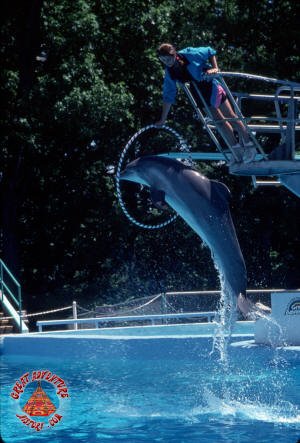 |
| |
|
|
 |

 |
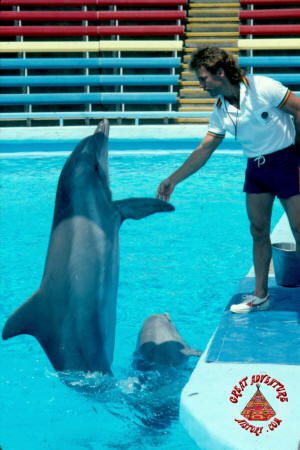 |
| |
|
 |
 |
| |
|
|
 |
 |
 |
| |
|
|
 |
 |
 |
| |
|
|
 |
The dive shows kept
coming season after season, with just the costumes and the performers
changing from year to year along with the names of the shows and/or
teams taking up residence. The dive shows and the dolphin shows were
contracted out for many years, with rotating performers coming from year
to year and sometimes even changing during the season. |
 |
| |
 |
| |
|
|
 |
The shows at the Aqua
Spectacle were one of Great Adventure's best known features and there
was a certain prestige to working at the show facility because of that.
The venue even had its own costumes for some time, with the ushers
dressing in stylized sailor uniforms that stood apart from the other
Show Operations costumes.
The stadium remained
largely unchanged for many years, with small additions and removals
taking place as new and updated shows were rolled out each year. |
 |
| |
|
 |
 |
| |
|
|
 |
 |
 |
| |
|
|
 |
 |
 |
| |
|
|
 |
 |
 |
| |
|
|
 |
The shows
were run from the sound booth high above the bleachers, with the sound
tech often introducing the show as well as playing the music and sound
effects throughout. The sound effects were played via a series of
"carts" which were tapes that they would plug in and play at the
appropriate times throughout the show.

 |
 |
| |
|
 |
 |
| |
|
 |
 |
| |
|
 |
With Time Warner taking ownership
of Six Flags in the 1990's a concerted effort was made to bring themed
areas back to their parks that had often lost any semblance of theme
over the years. For the 1993 season the area around the Aqua Spectacle
became the Lake Front, and nautical elements were added all around to
help further that idea. New signage was introduced along with themed
props. The area alongside the stadium between it and the Great Lake
Grandstand was turned into a sandy beach area complete with a sailboat. |
 |
| |
|
|
 |
 |
 |
| |
|
|
 |
For the 1995 season
big changes were in store for the Aqua Spectacle. The area from the
park's front gate to the stadium was rethemed, taking on a colonial
theme. The stadium received a new entry portal and a repainting and
update, becoming Fort Independence to fit the area's new look. The
stadium which had been painted in shades of aqua for twenty years was
suddenly a beige color with stone and wood accents.
Another huge
change was the discontinuation of dolphin and sea lion shows. Time
Warner was owner of Six Flags and Warner Brothers, and Warner produced
the movie "Free Willy" which was a story about a boy who fights to free
a killer whale from captivity and bring it back to the ocean. The
company was called on its hypocrisy for making a movie advocating for
the release of marine mammals from captivity while keeping them in its
parks, so a decision was made to discontinue any dolphin shows in the
parks.
|
 |
| |
|
 |
 |
| |
 |
|
 |
 |
| |
|
|
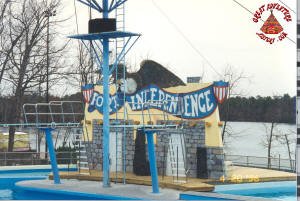 |
With the dolphin show
gone, the diving show was the only performance happening in the stadium
in 1995, and guests were disappointed. Though the dive show was fun,
many people came back year after year to see the dolphins and sea lions
perform. It had appealed to all ages in a way that rides failed to do,
alienating a demographic from the park.
To try and remedy
this situation, a bird show was introduced in 1996. The Masters of the
Sky show was a demonstration of the skills and abilities of an array of
large, trained birds including eagles, hawks and falcons. While the
magnificent birds were very interesting to watch and the show was good,
it failed to capture the attention of guests the way the dolphins had in
the past. |
 |
| |
|
 |
 |
| |
|
 |
 |
| 1997 |
|
|
 |
 |
 |
| |
|

 |
The dive
shows continued in the stadium for several more seasons, with new names
and costumes but still basically the same shows that had been playing
since the park opened in 1974. The jokes were updated each season to
include topical references as trends changed.
 |

 |
| |
 |
| |
|
|
 |
Click Left or Right to
view photos from
Aqua Spectacle
shows through the years. |
 |
| |
|
|
 |
 |
_small.jpg) |
| |
|
|
 |
 |
 |
| |
|
|
 |
 |
 |
| |
|
|
 |
With changes in
ownership, the decision was made to bring dolphins and sea lions back to
the park in the new millennium. This time it was just two dolphins and
two sea lions, but instead of being a contracted show, these animals
were owned by Six Flags and the trainers were part of the parks staff.
Six Flags ownership of Six Flags Marine World (now Discovery Kingdom) in
California meant that they had the expertise and the resources to
support the marine life show themselves rather than relying on a
contractor.



 |
 |
| |
 |
| |
|
 |
 |
| |
|
 |
 |
| |
|
 |
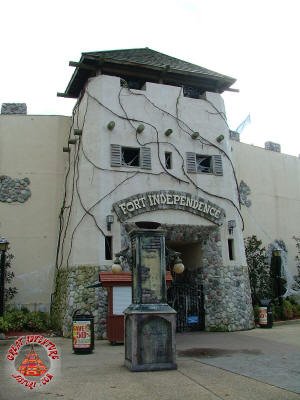 |
| |
|
|
 |
 |
 |
| |
|
|
 |
The new dolphin shows
were popular, and helped spread the message of conservation and
protection for wild animals through entertainment and education, which
was a winning formula developed by SeaWorld and other marine life parks
over the years. While there was still backlash from extremist animal
rights groups, much of the message of Free Willy was disproven when
Keiko, the whale who starred in the movie, was released into the wild
and was unable to adapt to life in the ocean after having spent so much
time in captivity.

 |
 |
| |
|
 |
 |
| |
|
|
 |
 |
 |
| |
|
|
 |
 |
 |
| |
|
|
 |
The schedule
for shows throughout the day was a fraction of what it had been in the
past, but new experiences with the dolphins and sea lions were offered
to park guests including behind the scenes training and photo
experiences. These new experiences were an up-charge offering, but
allowed guests willing to pay a chance to really get close to and
interact with the spectacular animals in a more intimate way than the
show ever could.



 |
 |
| |
|
 |
 |
| |
|
 |
 |
| |
|
 |
 |
| |
|
 |
 |
| 2008 |
|
 |
 |
| |
|
|
 |
 |
 |
| |
|
|
 |
 |
 |
| |
|
|
 |
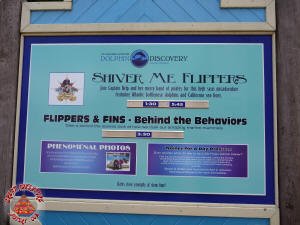 |
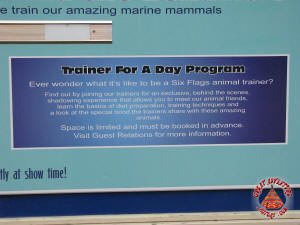 |
| |
|
|
 |
 |
 |
| |
|
|
 |
 |
 |
| |
|
|
 |
 |
 |
| 2010 |
|
|
 |
 |
 |
| |
|
|
 |
 |
 |
| |
|
|
 |
One of the biggest changes for the new dolphin and sea lion shows was
that the animals were kept at the park year round now. In the past, the
dolphins would get flown in from Florida in the spring then flown back
in the fall, creating stress for the animals as well as adding
logistical and financial complications. Now the animals could spend the
winter in the park working with their trainers who could take care of
them all through the off season.
The shows would also
perform new "spooky" versions for Great Adventure's annual Fright Fest
events. The silly shows were filled with bad jokes, but offered a
seasonal variation that guests who were fans of the show loved. |
 |
| |
|
 |

 |
| 2011 |
|
|
 |
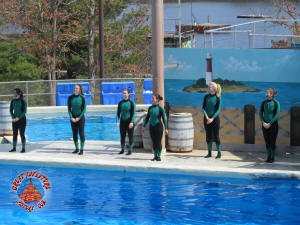 |
 |
| |
|
| The dolphin show
continued for several seasons, once again following the same basic
formula but with new routines and sequences from seasons to season along
with new names for the show. In more than 30 years, little had changed
in the stadium, with the original bleachers and lights and so many other
things staying the same for all that time. |
 |
| |
|
 |
 |
| |
|
|
 |
 |
 |
| |
|
|
 |
 |
 |
| |
|
|
 |
 |
 |
| |
|
|
 |
 |
 |
| |
|
|
 |
 |
 |
| |
|
|
 |
 |
 |
| |
|
|
 |
 |
 |
| |
|
|
 |

 |
 |
| |
|
 |
 |
| |
|
|
 |
For the 2012 season the bleachers in the stadium got a fresh new look
with the original rainbow of colors for the seat backs now being painted
in shades of blue. The darker blue seats at the bottom of the stadium
marked the "splash zone" where guests would often get wet from the high
flying antics of the dolphins and sea lions.
The season started
out with both dolphins and sea lions, but after one of the dolphins
contracted an illness and died, the decision was made to send the
remaining dolphin to Six Flags Discovery Kingdom in California and just
continue with a sea lion only show at Great Adventure. |
 |
| |
|
 |
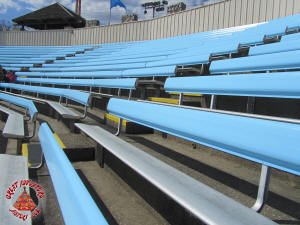 |
| |
|
 |
 |
| |
|
|
 |
 |
 |
| 2013 |
|
|
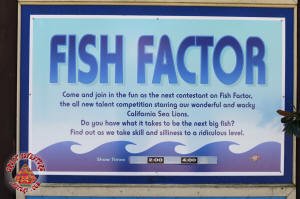 |
 |
 |
| |
|
|
 |
The sea lions
continued to be a popular show in the park, though guests still missed
the dolphins. The large and playful personalities of the sea lions along
with their athletic abilities continue to delight park guests as they
entertain and inform through their presentations. |
 |
| |
|
 |
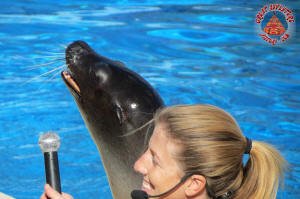 |
| |
|
|
 |
 |
 |
| |
|
|
 |
 |
 |
| |
|
|

